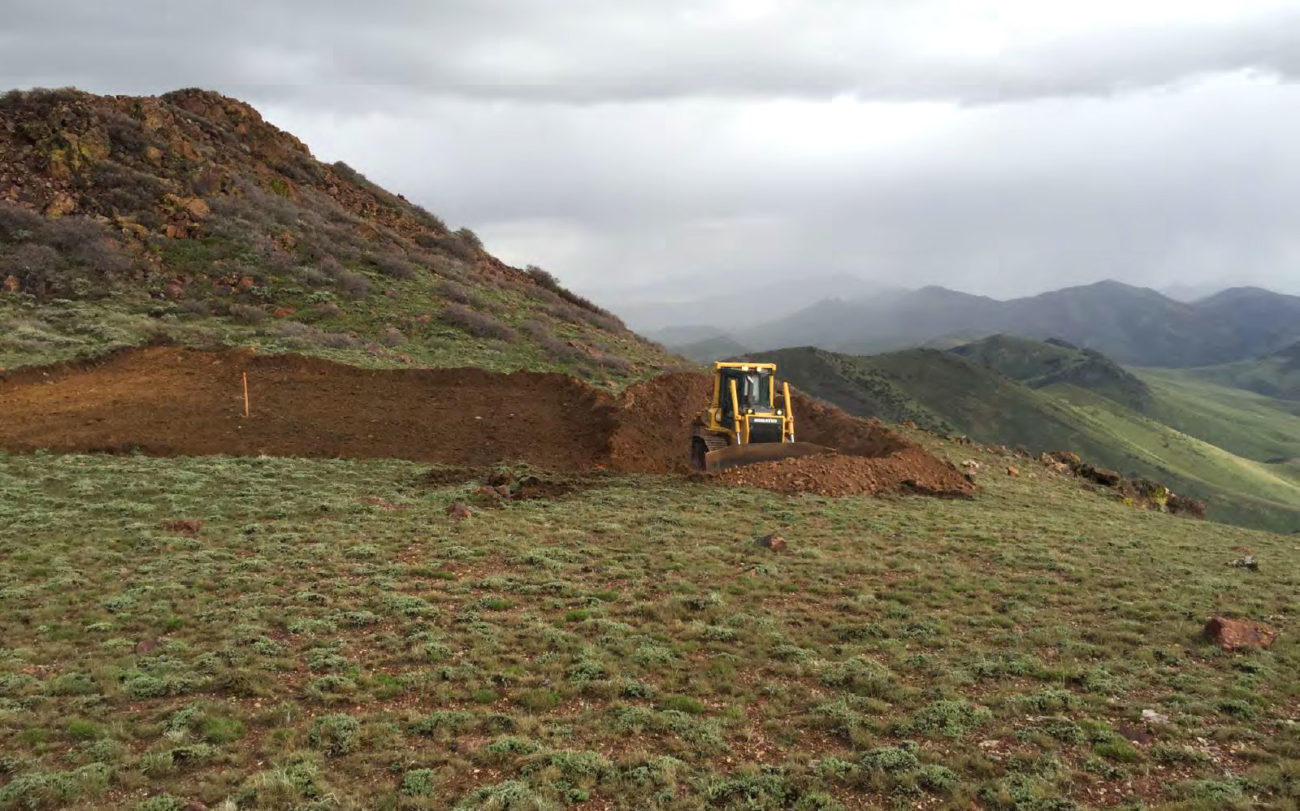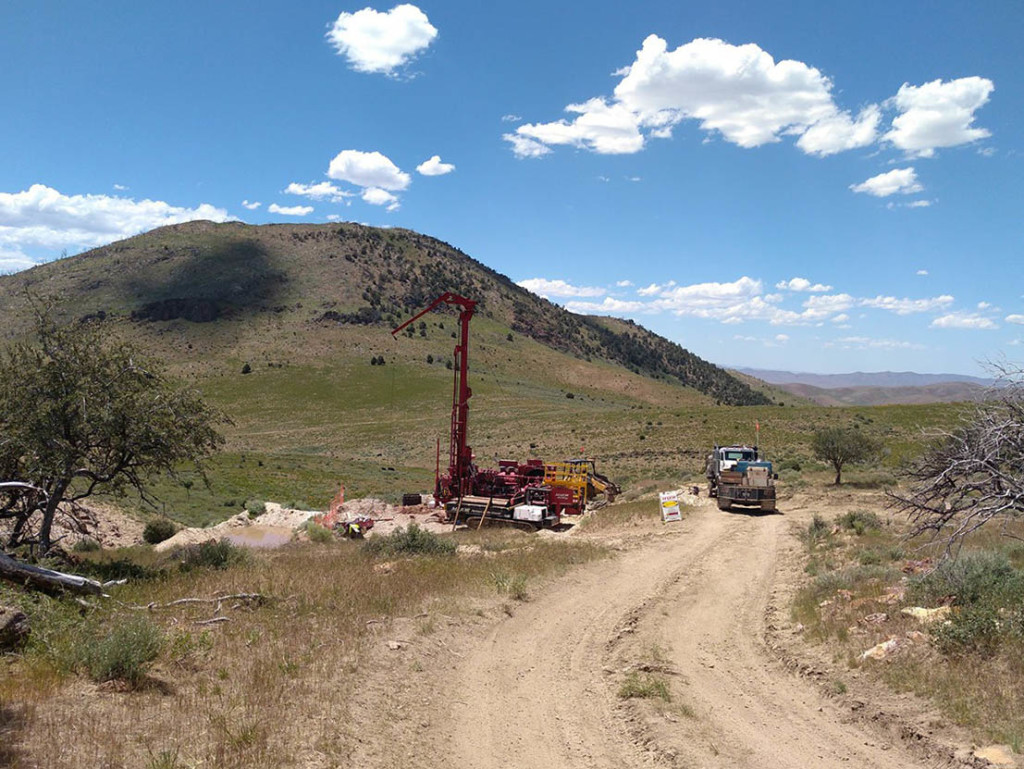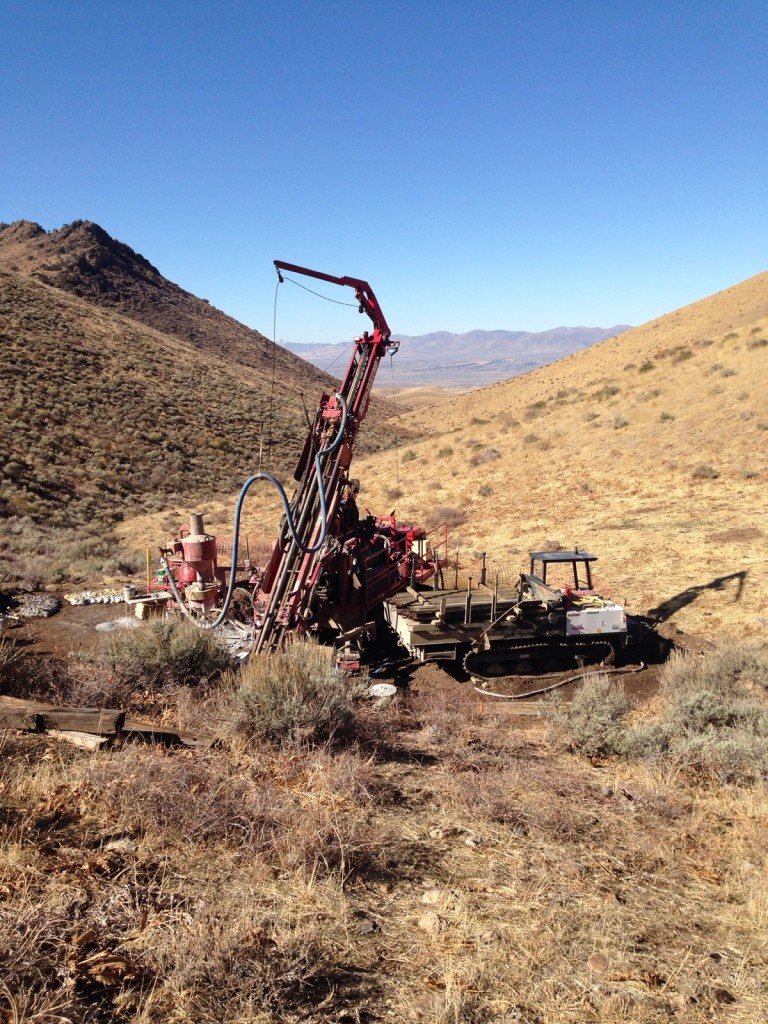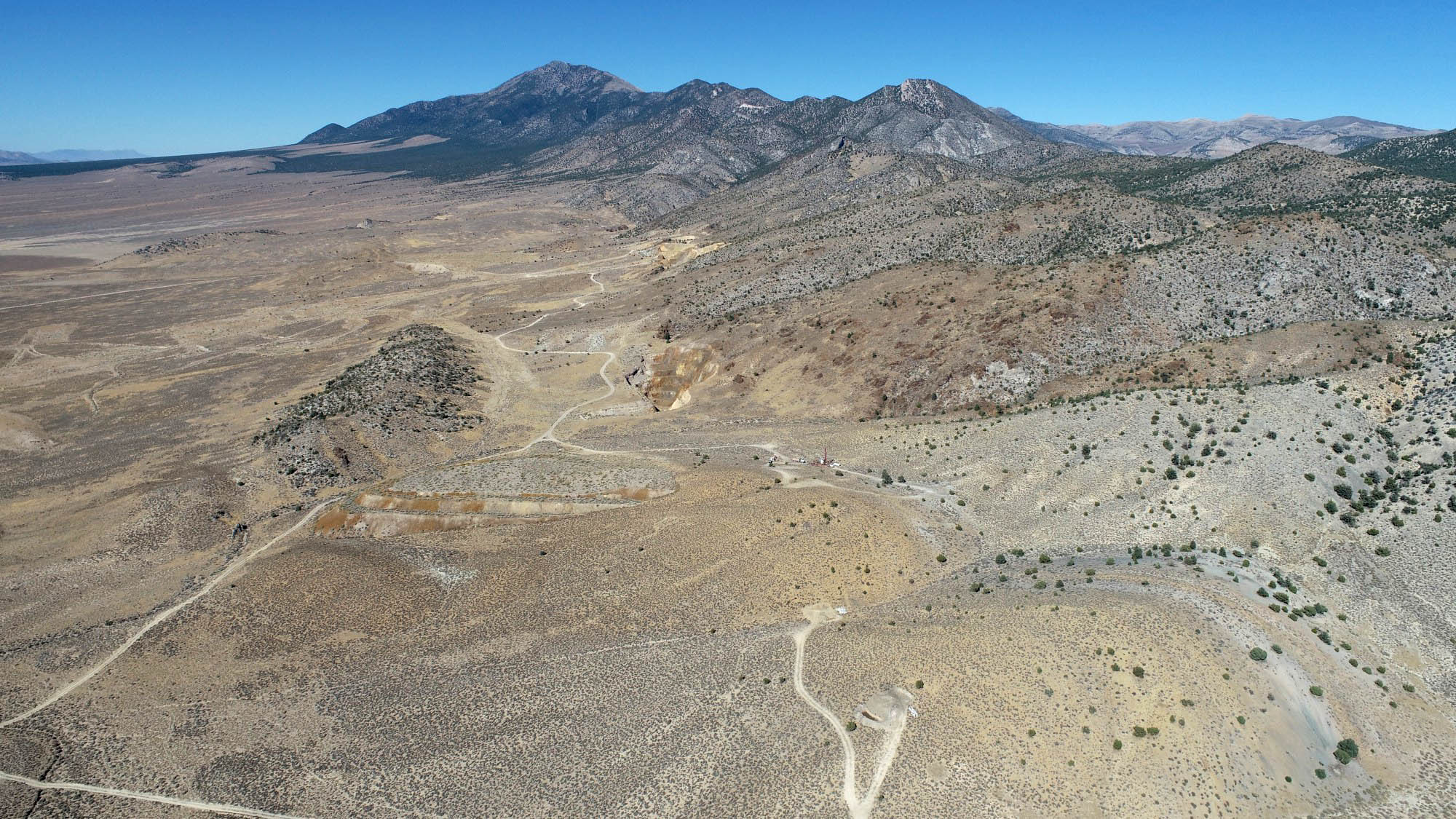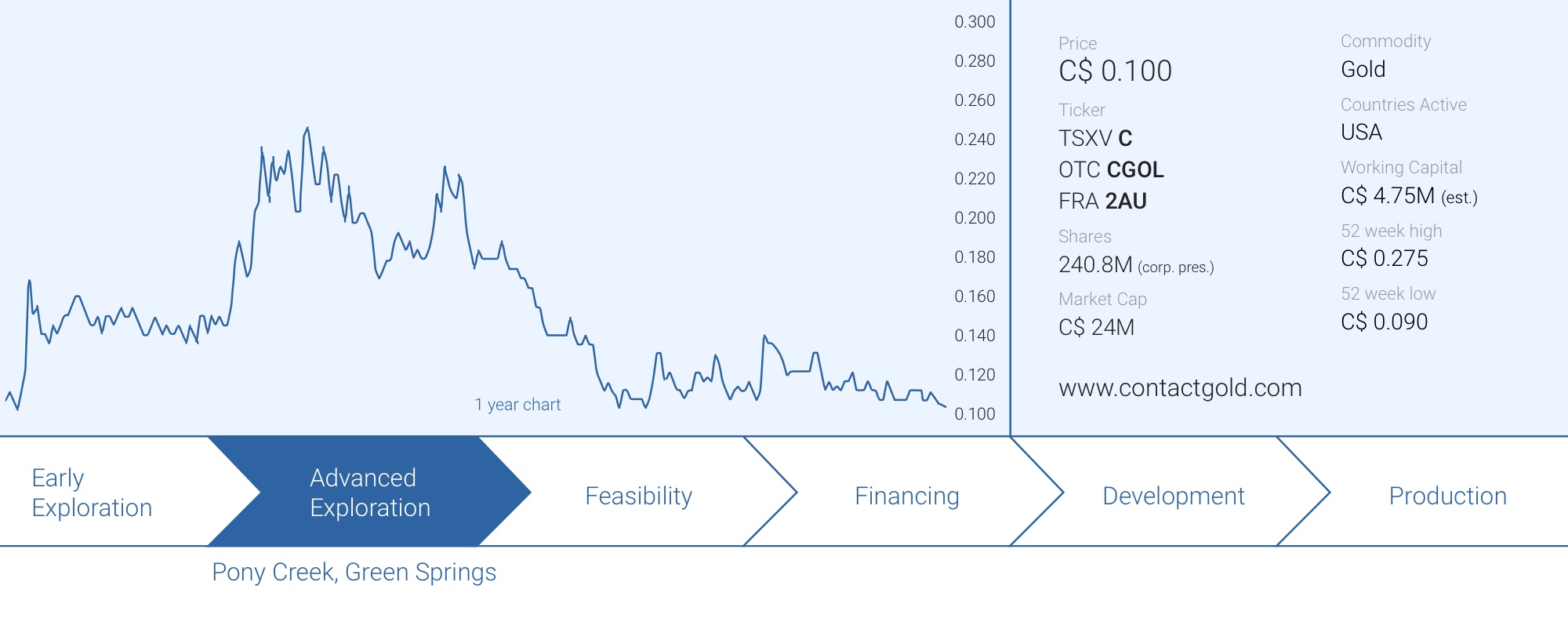
The almost final results of the 2020 drill program (4 holes still remain) at the Green Springs gold oxide project in Nevada have now been published and we can reasonably expect Contact Gold (C.V) to publish the initial results of its 2021 drill program relatively soon as this year’s drill program was kicked off a few weeks ago.
With almost all results from the 2020 drill program now in hand, this is a good moment to have a look at the achievements in 2020 and to check up on what we can expect in 2021.
A recap of the 2020 drill results at Green Springs
In its most recent exploration update, Contact Gold disclosed the assay results of three holes drilled on the Echo zone (southern part of the Mine Trend – the Company rebranded the N-S corridor, from Bravo in the north to the new Zulu discovery in south, the Mine Trend). All three holes contained mineralization with 19.66 meters containing 1.53 g/t gold as headline result (including 12.04 meters of 2.02 g/t gold) but the mineralization in the other two holes also appears to exceed the cutoff grades.

The important takeaway from the Echo drilling update is the consistency and the continuity. The image below shows the southern portion of the Mine Trend at Green Springs and as gold mineralization has been encountered at both Echo and Zulu, the mineralized trend remains open towards the south beyond the now established three kilometer long Mine Trend.

These are the penultimate assay results of the 2020 drill program (assay results from four more holes remain outstanding) and Contact Gold has provided updates on a consistent basis. The previous batch of assay results was announced in February and zoomed in on the five holes drilled at Charlie, the center of the Mine Trend.
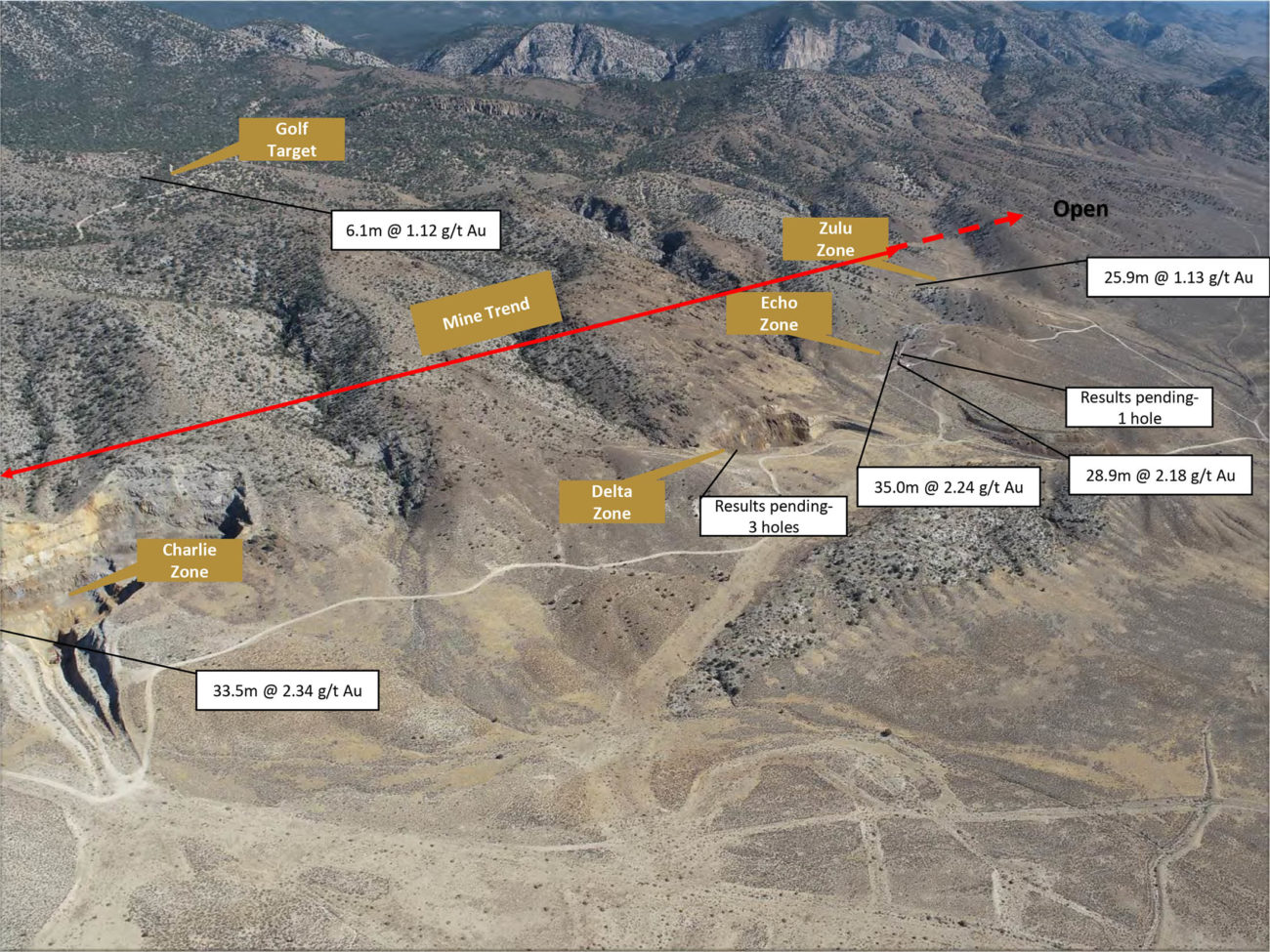
While all five holes (of that previous batch) did encounter gold mineralization we can reasonably expect four of the holes to exceed the cut-off grades for Nevada based gold oxide operations (the narrow 1.5 meters of 0.21 g/t gold encountered in hole 29 remains below a reasonable cutoff grade and is mentioned in the table as ‘no reportable intercepts’). The same comment is valid for hole 7, which is reported in the table as ‘no reportable intercepts’ although 3.05 meters of 0.15 g/t gold was intersected. That’s below the cutoff grade, so Contact Gold is being very correct by not even mentioning below cutoff grades in its overview. So although some of the holes appear to be ‘empty’ in the table, there seem to be sniffs of gold.
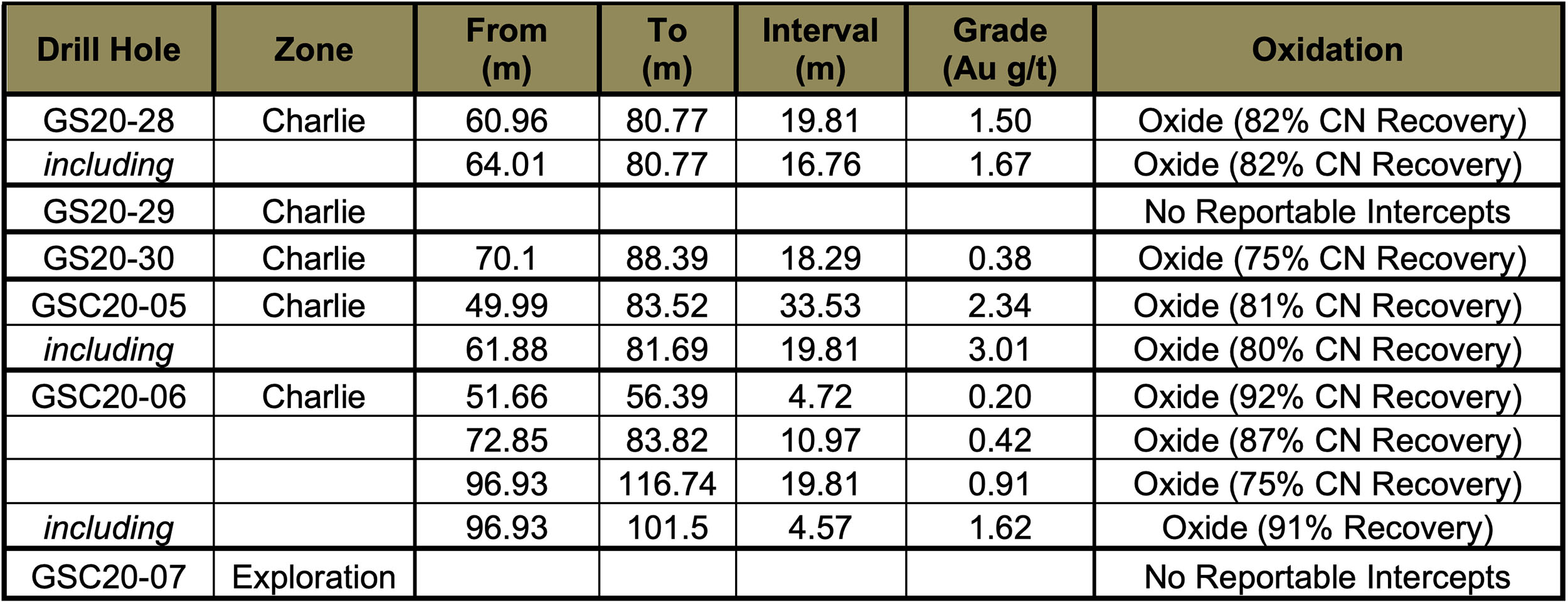
The main highlight was obviously a 33.5 meter interval with an average grade of 2.34 g/t gold while hole 28 encountered almost 20 meters of 1.5 g/t gold. But there was another intriguing element. Hole 6, which was drilled towards the north of the other holes but after a fault, also encountered gold mineralization with almost 11 meters of 0.42 g/t gold and almost 20 meters of 0.91 g/t gold. That’s an important step forward as this could allow Contact to trace the gold all the way from Charlie to Bravo but more drilling will obviously be needed to confirm this.

Contact Gold also drilled a few holes at the Golf target, which is located about 1,200 meters east of the Mine Trend. The holes drilled at Golf could perhaps be considered wildcat holes as they were intended to deliver proof of concept for gold mineralization hosted in the pilot shale, a major host of gold mineralization on the property.
While the grades are rather weak (7.6 meters of 0.83 g/t is good but 4.57 meters of 0.29 g/t gold is rather poor while 3 of the 5 holes did not encounter any significant mineralization), Contact Gold seems to be happy with its proof of concept as the company has now confirmed the pilot shale actually is mineralized on other areas of the property and not just at the Mine Trend. While the grades and intervals aren’t great, this will help to interpret the structures at Golf and perhaps Contact will be able to finetune its future drill programs trying to improve the grade and increase the size of the mineralized footprint. In any case, the Golf target provides icing on the cake and the near-term value will likely be unlocked at the mine trend where the grades and intervals are more consistent (and higher).
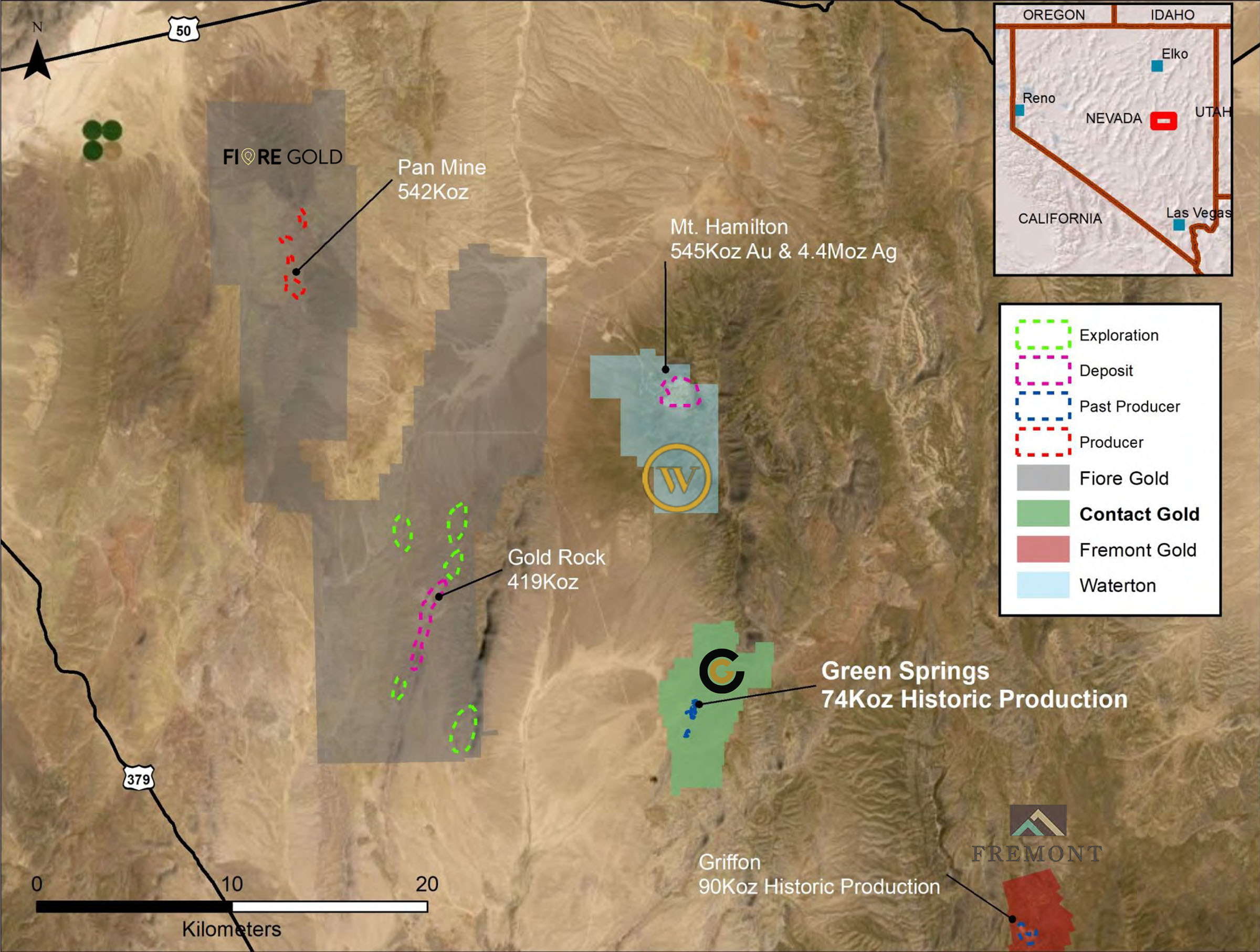
Contact Gold will be very active this year
Contact Gold didn’t wait for the final assay results to come in to kick off its 2021 exploration season. An initial 6,000 meter drill program has started (twelve holes have already been completed so far!) and the focus this year will be on drilling the three kilometer long Mine Trend.
The approach will shift as well. Until now, the company was focusing on the separate zones but will now start to apply a holistic overview and look at Green Springs as a series of mineralized deposits by connecting the zones. This will provide better insight in the continuity and the scale of the Green Springs project where Contact Gold is now planning to drill more deeper holes to drill-test the pilot shale (up to 150 meters deep). That’s rather deep but considering some of the deeper holes have confirmed the mineralization is still oxidized at depth even deeper mineralization should be viable thanks to the generally good to excellent leach kinetics.
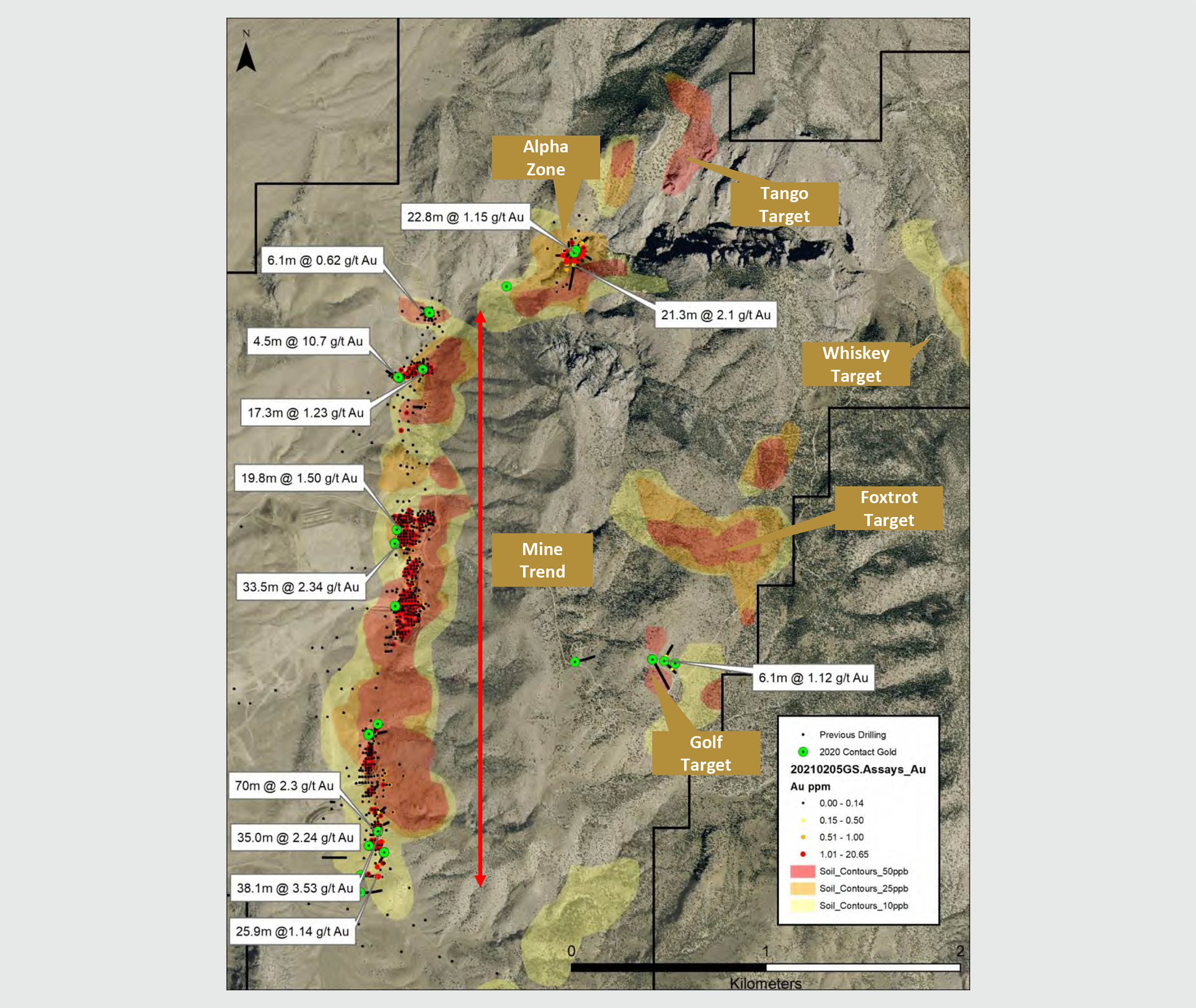
On top of drilling out the Mine Trend, Contact will continue to drill a few additional holes we could best describe as wildcat holes (early stage exploration drilling outside of the 3 kilometer mine trend). Included among those in the highly anticipated, never before drilled, Tango target, 500m of the Alpha Zone. This target has the best footprint of gold-in-soil and gold-in-rocks, at surface, on the project and could easily yield a new significant discovery. The Foxtrot target will be drilled for the first time ever while the pilot shale target beneath the Golf zone will be drill-tested as well as the real exploration target there isn’t a near-surface target, but the lower pilot shale.
Let’s not forget about Pony Creek – will the project become ‘in play’ again?
While we expect most attention (and funds) will be focusing on Green Springs, we shouldn’t forget about Contact Gold’s previous flagship project. The Pony Creek project remains in good standing and it’s a pity the project has been put on the backburner as the Green Springs project is perhaps a bit easier and more straightforward to drill out.
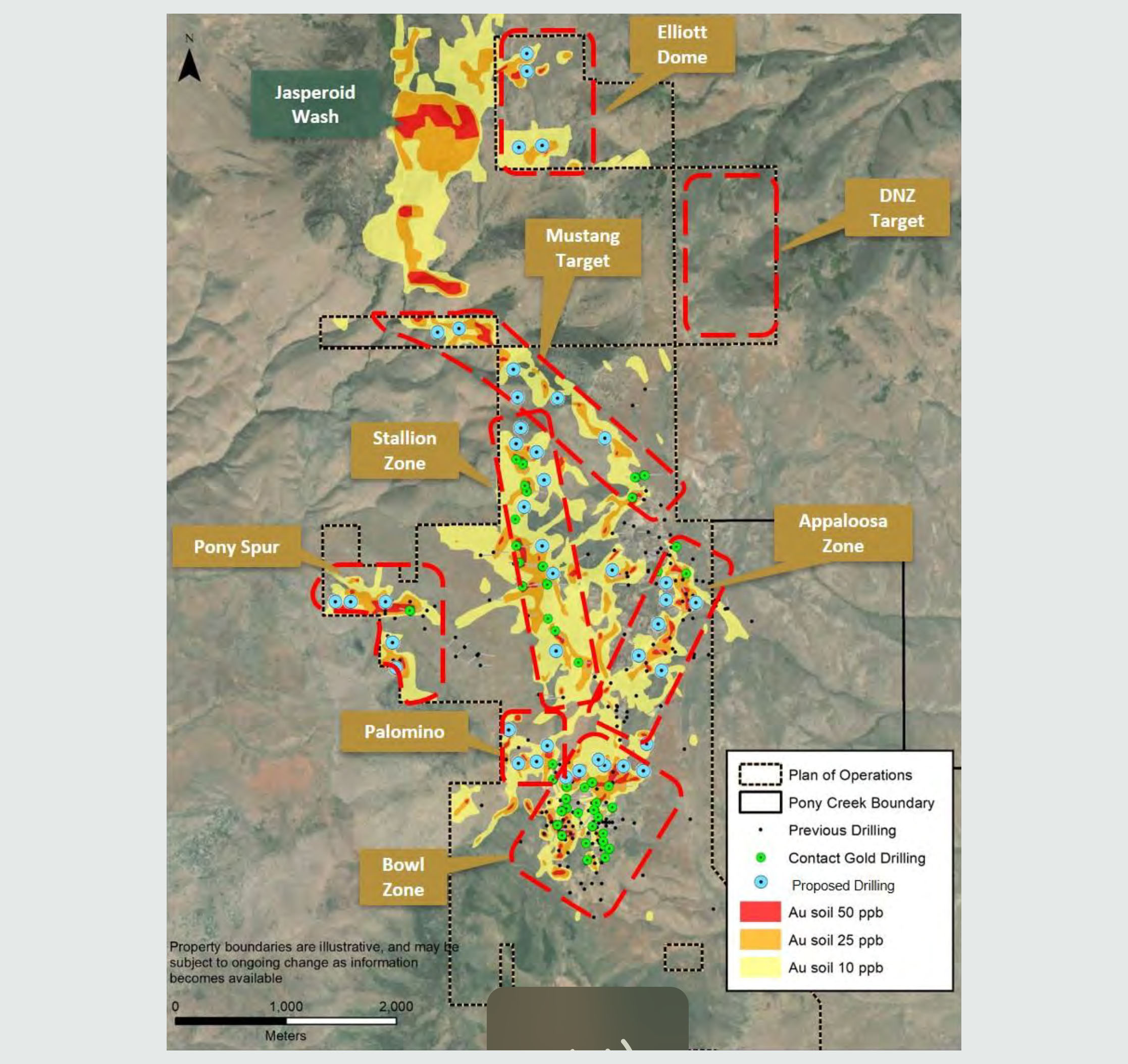
As you may remember, the main issue at Pony Creek was the limited exploration approach before the plan of operations was approved, which severely hindered the company in constructing drill pads and drilling holes in the most optimal locations. The plan of operations has now been approved (this happened in June 2020) and this will allow Contact Gold to have a more flexible exploration approach. But with all eyes on Green Springs, Pony Creek now needs to take a back seat although the recently uploaded corporate presentation seems to hint at a potential drill program at Pony Creek in the second half of the year.
The main question coming to mind is who will own or bankroll the exploration project. As you know, the Pony Creek project is literally adjacent to the main mineralized zones of the Gold Standard Ventures (GSV, GSV.TO) and according to the Vancouver rumor mill, the relationship with Gold Standard hasn’t always been great. But as Gold Standard Ventures recently installed a new management team, this could be a good moment to turn the page and reset the relationship. It’s quite obvious both the GSV projects and the Pony Creek project should be seen as one large district play instead of the current fragmentation into two projects. It would make sense for both projects to end up under the same owner but let’s not get ahead of ourselves and perhaps Contact should complete at least one additional round of drilling to make Pony Creek more appealing to potentially interested parties.
The recently filed financials indicate Contact Gold is still in good shape
Contact Gold filed its financial results last week and according to the most recent balance sheet, the company ended 2020 with approximately C$4.75M in cash on the balance sheet while an additional C$336,000 was added to the current assets as prepaids and deposits. Deducting the C$413,000 in current liabilities from the C$5.16M in current assets results in a net working capital position of almost exactly C$4.75M which means Contact Gold is in a good shape.
The direct consequence of the strong cash position is the fact the initial 6,000 meter drill program at Green Springs appears to be fully funded. Should a Phase 2-2021 drill program be kicked off later this year Contact Gold may have to raise some money to make sure it keeps enough cash in the till to prevent market forces from ‘betting against’ a company. When non-revenue companies see their cash levels drop below a certain level, the market could turn against them as investors could be betting being able to ‘reload’ their position in a financing and score a free (half) warrant. By keeping an eye on the cash position and proactively raise cash whenever there’s a financing window, Contact Gold will be able to avoid being pushed into a corner.
We also noticed an interesting tidbit of information in the Management Discussion & Analysis. The Dixie Flats, North Star and Woodruff properties have been optioned out to an (unnamed) third party as Contact Gold seems to be rationalizing its asset portfolio. The optionor will have to complete a few cash payments totalling US$500,000 before earning full ownership of the assets (subject to the royalties payable to Waterton and a newly created 0.25% NSR on Dixie Flats, payable to Contact Gold).

Another helpful factor to raise money in the future will be Contact Gold’s redomiciliation as a Canadian company rather than being a US-domiciled company. As you may know, there are some additional hoops to jump through when a company is classified as a US company with for instance a 12 month hold period (which could be reduced to 6 months if the company has an up-to-date prospectus available) which may reduce the level of interest of potential investors. Upon redomiciling the company in Canada, Contact Gold will still have to file its documentation with the SEC, but when it comes to capital raises the Canadian rules (4 months holding period in normal placements, free trading shares in a bought deal financing) will apply and this could make things considerably easier for CFO Wenger.
Conclusion
2020 was a busy exploration year for Contact Gold and the drill results from the Green Springs project are very satisfying and provide a good platform to continue to build on. We expect the initial 6,000 meter drill program planned for the first semester to be expanded throughout the summer (subject to the financing needs, of course) and this could perhaps put Contact Gold in a position to work on a maiden resource estimate at Green Springs. While we understand why the company wants to drill a few more (semi-) wildcat holes on some of the targets close to the Mine Trend, we sincerely hope the main focus will be on obtaining an initial resource at Green Springs.
Green Springs will undoubtedly remain the flagship asset this year but perhaps Contact Gold can put its recently received plan of operations to good use and design a high-impact drill program to drill-test its high-priority drill targets.
Contact’s share price is trading at the exact same levels as where it was trading at about a year ago (despite reaching a high of C$0.275 in July) and that’s frustrating as the company continues to make good progress on its assets.
Disclosure: The author holds a long position in Contact Gold. Contact Gold is a sponsor of the website. Please read our disclaimer.
